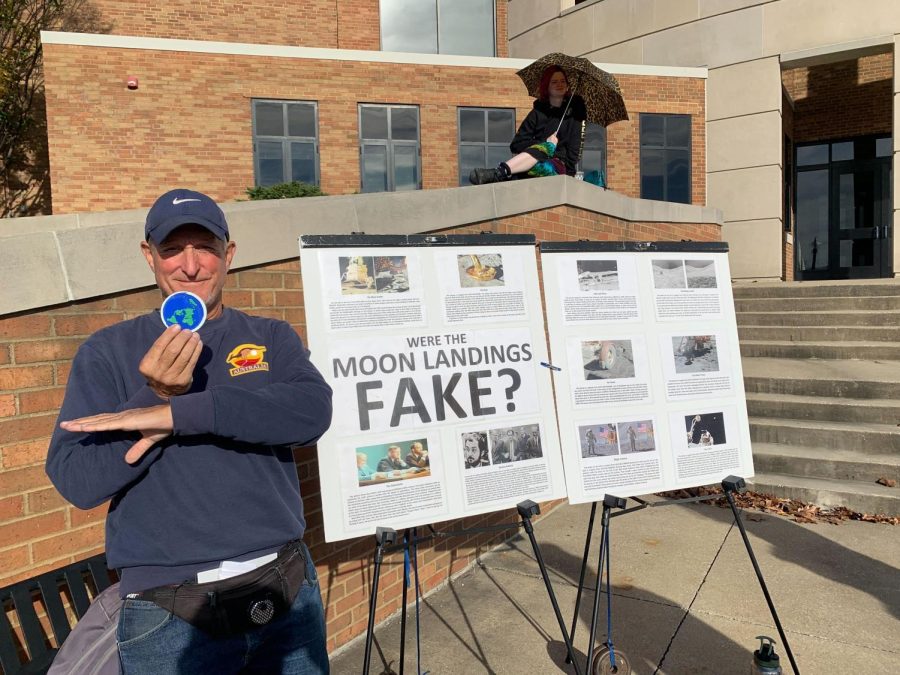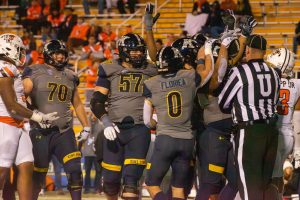Flat Earth advocate detained on campus
Peter Jarvio handed out 3D-printed models of a flat Earth and explained why the moon landing was fake to students on the University Esplanade.
November 11, 2022
A man advocating the moon landings were fake and the Earth is flat was handcuffed and detained Tuesday by Kent State University police as they attempted to identify him.
Police arrived at the University Esplanade in front of the M.A.C. Center, following an emergency call that reported a fight between Peter Jarvio, who set up an informational display stating the moon landings were faked and the Earth is flat, and an unidentified male, according to the police report. The report states that following a heated discussion, the unidentified male knocked over Jarvio’s signs. The unidentified male “was upset by this theory because he is a physicist and the Earth is not flat,” which resulted in a physical altercation with Jarvio, the report stated.
“I was talking to somebody, this student ran up behind me saying I’m lying, lying and took my posters and threw them on the ground,” Jarvio said. “I was upset. I went and I think I grabbed his backpack or jacket and he went to the ground. I straddled him, full guard I think they call it in MMA, and I pulled his glasses off, because I figured he needed his glasses.”
The two men were separated when police arrived—an officer explained to the unidentified male that he could not throw a person’s property to the ground because he did not agree with the message, the report stated. At the same time, police ran both men’s IDs through the Law Enforcement Automated Data System, a police database operated by the Ohio Highway Patrol. The unidentified male’s ID came back but Jarvio’s did not, since he is from Kentucky. After retrieving Jarivo’s ID, police noticed “the top of the Kentucky driver’s license said something to the effect of, ‘not for real ID purposes,’” so they placed Jarvio in handcuffs to detain him, according to the report.
Kent State Police Sergeant Tricia Knoles said the lieutenant opted to place Jarvio, whose information had just arrived late from Kentucky, in handcuffs for the safety of those around him while he was detained until officers could identify him.
“I don’t think that necessarily you would have to use handcuffs, but that would not be very safe to not secure somebody that you’re detaining,” she said. “Because if that person is giving you false information, say they have a warrant for murder or something like that and then they know you’re going to find out, now you’re leaving their hands free, if they have weapons on them, they can take off easier away from you, which can also be a safety factor for the community.”
In 2015 the Sixth Circuit Appellate Court addressed factors that would allow law enforcement to place a detained subject in handcuffs in Brown v. Lewis, 14.
“If there is no specific reason for the officers to believe that the detainee poses a risk of flight or violence, ‘a bare inference’ or speculation that the detainee may somehow be violent is not sufficient to justify the use of handcuffs,” the document stated.
Knoles said the decision to detain Jarivo was based both on his identification not coming back immediately from their database and the lieutenant’s suspicion over the “not for real ID purposes” label.
“You have to understand when someone makes a decision to detain a person, you have to look at the entire thing. The main thing would be the first part where nothing came back from the state of Kentucky on his information, ” Knoles said. “So, the totality of the circumstances would be the two of those things together, that he doesn’t have a Real ID that has been checked with verifiable other information in order to get a Real ID.”
Real ID is a security standard set by Homeland Security to allow individuals access to “certain federal facilities, entering nuclear power plants and boarding federally regulated commercial aircraft,” according to the department’s website, and does not affect an individual’s ability to use it as identification. Half of all the states have not yet implemented Real ID changes since its enactment sixteen years ago and therefore identification cards and drivers licenses from those states are labeled with the phrase “not for Real ID purposes.” Knoles said it is her understanding the lieutenant is aware of this but that many fake IDs, which are intended to be exact copies of legitimate IDs, also have this phrase.
When getting a fake ID, they typically come from Pennsylvania or Illinois, and are not as enhanced as a driver’s license, Knoles said, and don’t include as much information as the originals.
“In this case, this person did not get one of those IDs where you have to show more information to prove that as you, so therefore, technically you can’t use it for Real ID purposes,” Knoles said. “But if we’re running that and it comes back verified through LEADS then that verifies who that person is.”
Despite this, Jarvio, who said he has brought his demonstration to thirty universities, said he was satisfied with the way police handled the incident and looks forward to spreading his message to students at Kent State.
“I don’t like the lies and that spherical ball, globe Earth is not the truth,” he said. “It’s a lie. It’s propaganda.”
Alton Northup is a staff reporter. Contact him at [email protected].

















Ron • Nov 14, 2022 at 8:15 am
Wait, now — they let the unnamed attacker go and cuffed the victim? Am I reading that right?